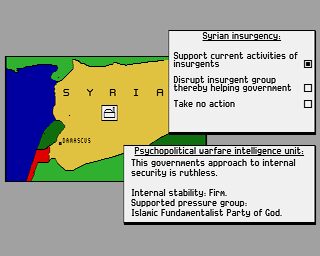
Author: GN Team - Published: 14 November 2020, 2:06 pm
Conflict: Middle East Political Simulator is a strategy game created by PSI Software. It was published by Virgin Mastertronic in 1990 for PC, Amiga, and Atari ST.
In this original turn-based simulation, set in 1997 (seven years in the future at the time), game designer David Eastman imagines that the Israeli prime minister is killed and that the player takes his place. As you might know, prime minister Yitzhak Rabin was actually assassinated in 1995, so somehow, the game predicted the future.
As the new pm, you must manage the complex situation with your neighbors: Egypt, Syria, Jordan, Lebanon, etc. As in the real world, you have a powerful friend, the U.S., if you need help. You will need it because resources and budgets are limited, so your life won't be easy.
Read More
Author: Gustavo - Published: 7 November 2020, 12:09 pm
Zeppelin: Giants of the Sky is a business simulation/strategy game developed by Ikarion and published by Microprose in 1995 for Amiga and MS-DOS. that puts you in charge of a Zeppelin company in 1900.
People who consider themselves "young adults" have an essential role in the history of video games. We still remember the first games pretty fondly, but we are also looking forward to some of the latest releases. One could say that we saw it all... Or so I thought before I found out that there is a game about zeppelins. I´m not talking about a game with a zeppelin background or that the protagonist is obsessed with zeppelins, but a title based exclusively on them and their administration. For good or ill, this is Zeppelin: Giants of the Sky.
Read More
Author: GN Team - Published: 5 November 2020, 8:23 pm
Frenetic is a vertical shooter created by Core Design and released for Amiga and Atari ST in 1991.
It's a traditional game that perfectly fits the space shoot-em-up genre, including masterpieces such as Xenon 2: Megablast and Hybris. Frenetic is divided into eight vast levels that alternate between technological and alien-organic design. Of course, there are plenty of enemies, power-ups, weapons, and end-of-level bosses. In this, the game does not try to innovate too much.
The most discussed decision is the reset of all weapons and power-ups when you lose a life, something very frustrating for the players. Anyway, Frenetic has a feature you don't find in many other games: this shoot-em-up by Core Design can be played by two players simultaneously in co-op. If you are with a friend, you are lucky! Have fun!
Read More
Author: GN Team - Published: 4 November 2020, 10:40 pm
The Misadventures of Flink (or simply Flink) is a jump-and-run game created by Psygnosis and published in 1994. It was released for the Amiga CD32, Sega Mega Drive, and SEGA CD.
The game, designed and illustrated by Henk Nieborg, inspired the follow-up/remake The Adventures of Lomax. If Lomax had the excellent addition of the Lemmings characters, Flink has other exciting features. First, the spells' mechanics: your character will collect scrolls and ingredients during the game; once he has enough, he can combine ingredients to create new spells. Anyway, since he is still an apprentice, the result is not assured! Of course, the successful ones will become part of his book, which he can use later during the game.
Read More
Author: GN Team - Published: 4 November 2020, 6:51 pm
Batman: The Movie (or, more simply, Batman) is an action game based on the 1989 Batman film directed by Tim Burton.
Developed by Ocean Software, it was released in 1989 for the Amiga, Amstrad CPC, Atari ST, Commodore 64, MS-DOS, and ZX Spectrum.
Strictly following the movie's plot, Batman is made of 5 different games: 2 side-scrolling platformers, two driving games, and a puzzle game, each based on a different scenario taken from the film. The first level is a platformer on the chemical plant, while in the second, the player will have to drive the Batmobile. The third level is a puzzle game, with Batman running analysis in the Batcave. The fourth takes place during the Joker parade, and the player will have to drive the Bat-Jet. The final level is again a platformer, and it takes place in the Cathedral, where the epic last fight will happen.
Read More
Author: GN Team - Published: 4 November 2020, 6:51 pm
Total Recall is the adaptation of the science-fiction movie directed by Paul Verhoeven, starring Arnold Schwarzenegger. The game was released in 1990, the same year of the film, and Ocean published it.
Active Minds developed two versions, one for 8-bit platforms and another for Atari ST and Amiga (the one you will find here). Unfortunately, like many other movie conversions, the quality of this title is not exceptional. It also seems that part of the team left during production, and Ocean had to complete the game with other developers. Not good.
Read More